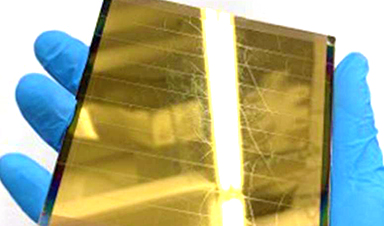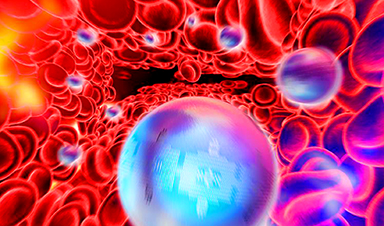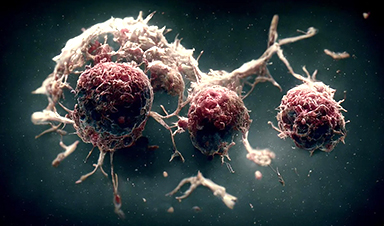As demand for solar energy rises around the world, scientists are working to improve the performance of solar devices—important if the technology is to compete with traditional fuels. But researchers face theoretical limits on how efficient they can make solar cells.
“Some researchers in the literature have hypothesized and showed results that up-conversion nanoparticles provide a boost in performance,” said Shashank Priya, associate vice president for research and professor of materials science and engineering at Penn State. “But this research shows that it doesn’t matter if you put in up-conversion nanoparticles or any other nanoparticles—they will show the boosted efficiency because of the enhance light scattering.”
Adding nanoparticles is like adding millions of small mirrors inside a solar cell, the scientists said. Light traveling through the device hits the nanoparticles and scatters, potentially hitting other nanoparticles and reflecting many times within the device and providing a noticeable photocurrent enhancement.
The scientists said this light scattering process and not up-conversion led to boosted efficiency in solar devices they created.
“It doesn’t matter what nanoparticles you put in, as long as they are nanosized with specific scattering properties it always leads to an increase in efficiency by a few percentage points,” Kai Wang said, assistant research professor in Department of Materials Science and Engineering, and co-author of the study. “I think our research provides a nice explanation on why this type of composite light absorbing structure is interesting for the solar community.”
Up-conversion nanoparticles work by absorbing infrared light and emitting visible light that solar cell can absorb and convert into additional power. Almost half of the energy from the sun reaches the Earth as infrared light, but most solar cells are unable to harvest it. Scientists have proposed that tapping into this could push solar cell efficiency past its theoretical ceiling, the Shockley-Queisser (SQ) limit, which is around 30% for single-junction solar cells powered by sunlight.
Previous studies have shown a 1% to 2% boost in efficiency using up-conversion nanoparticles. But the team found these materials provided only a very small boost in perovskite solar devices they created, the scientists said.
“We were focused initially on up-converting infrared light to the visible spectrum for absorption and energy conversion by perovskite, but the data from our Penn State colleagues indicated this was not a significant process,” said Jim Piper, co-author and emeritus professor at Macquarie University, Australia. “Subsequently we provided undoped nanocrystals that do not give optical up-conversion and they were just as effective in enhancing the energy conversion efficiency.”
The team performed theoretical calculations and found the boost in efficiency instead resulted from the nanoparticles’ ability to improve light scattering.
“We started to basically play around with nanoparticle distribution in the model, and we started to see that as you distribute the particles far away from each other, you start to see some enhanced scattering,” said Thomas Brown, associate professor at the University of Rome. “Then we had this breakthrough.”
Adding the nanoparticles boosted the efficiency of perovskite solar cells by 1% in the study, the scientists reported in the journal ACS Energy Letters. The scientists said changing the shape, size and distribution of nanoparticles within these devices could yield higher efficiencies.
“So some optimum shape, distribution or size can actually lead to even more photocurrent enchantment,” Priya said. “That could be the future research direction based on ideas from this research.”
News
Fever-Proof Bird Flu Variant Could Fuel the Next Pandemic
Bird flu viruses present a significant risk to humans because they can continue replicating at temperatures higher than a typical fever. Fever is one of the body’s main tools for slowing or stopping viral [...]
What could the future of nanoscience look like?
Society has a lot to thank for nanoscience. From improved health monitoring to reducing the size of electronics, scientists’ ability to delve deeper and better understand chemistry at the nanoscale has opened up numerous [...]
Scientists Melt Cancer’s Hidden “Power Hubs” and Stop Tumor Growth
Researchers discovered that in a rare kidney cancer, RNA builds droplet-like hubs that act as growth control centers inside tumor cells. By engineering a molecular switch to dissolve these hubs, they were able to halt cancer [...]
Platelet-inspired nanoparticles could improve treatment of inflammatory diseases
Scientists have developed platelet-inspired nanoparticles that deliver anti-inflammatory drugs directly to brain-computer interface implants, doubling their effectiveness. Scientists have found a way to improve the performance of brain-computer interface (BCI) electrodes by delivering anti-inflammatory drugs directly [...]
After 150 years, a new chapter in cancer therapy is finally beginning
For decades, researchers have been looking for ways to destroy cancer cells in a targeted manner without further weakening the body. But for many patients whose immune system is severely impaired by chemotherapy or radiation, [...]
Older chemical libraries show promise for fighting resistant strains of COVID-19 virus
SARS‑CoV‑2, the virus that causes COVID-19, continues to mutate, with some newer strains becoming less responsive to current antiviral treatments like Paxlovid. Now, University of California San Diego scientists and an international team of [...]
Lower doses of immunotherapy for skin cancer give better results, study suggests
According to a new study, lower doses of approved immunotherapy for malignant melanoma can give better results against tumors, while reducing side effects. This is reported by researchers at Karolinska Institutet in the Journal of the National [...]
Researchers highlight five pathways through which microplastics can harm the brain
Microplastics could be fueling neurodegenerative diseases like Alzheimer's and Parkinson's, with a new study highlighting five ways microplastics can trigger inflammation and damage in the brain. More than 57 million people live with dementia, [...]
Tiny Metal Nanodots Obliterate Cancer Cells While Largely Sparing Healthy Tissue
Scientists have developed tiny metal-oxide particles that push cancer cells past their stress limits while sparing healthy tissue. An international team led by RMIT University has developed tiny particles called nanodots, crafted from a metallic compound, [...]
Gold Nanoclusters Could Supercharge Quantum Computers
Researchers found that gold “super atoms” can behave like the atoms in top-tier quantum systems—only far easier to scale. These tiny clusters can be customized at the molecular level, offering a powerful, tunable foundation [...]
A single shot of HPV vaccine may be enough to fight cervical cancer, study finds
WASHINGTON -- A single HPV vaccination appears just as effective as two doses at preventing the viral infection that causes cervical cancer, researchers reported Wednesday. HPV, or human papillomavirus, is very common and spread [...]
New technique overcomes technological barrier in 3D brain imaging
Scientists at the Swiss Light Source SLS have succeeded in mapping a piece of brain tissue in 3D at unprecedented resolution using X-rays, non-destructively. The breakthrough overcomes a long-standing technological barrier that had limited [...]
Scientists Uncover Hidden Blood Pattern in Long COVID
Researchers found persistent microclot and NET structures in Long COVID blood that may explain long-lasting symptoms. Researchers examining Long COVID have identified a structural connection between circulating microclots and neutrophil extracellular traps (NETs). The [...]
This Cellular Trick Helps Cancer Spread, but Could Also Stop It
Groups of normal cbiells can sense far into their surroundings, helping explain cancer cell migration. Understanding this ability could lead to new ways to limit tumor spread. The tale of the princess and the [...]
New mRNA therapy targets drug-resistant pneumonia
Bacteria that multiply on surfaces are a major headache in health care when they gain a foothold on, for example, implants or in catheters. Researchers at Chalmers University of Technology in Sweden have found [...]
Current Heart Health Guidelines Are Failing To Catch a Deadly Genetic Killer
New research reveals that standard screening misses most people with a common inherited cholesterol disorder. A Mayo Clinic study reports that current genetic screening guidelines overlook most people who have familial hypercholesterolemia, an inherited disorder that [...]





















